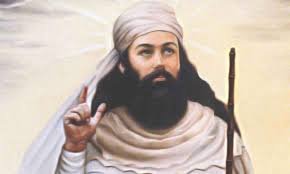Zoroaster (/ˈzɒroʊæstər/, UK also /ˌzɒroʊˈæstər/; Greek: Ζωροάστρης, Zōroastrēs), also known as Zarathustra (/ˌzærəˈθuːstrə/, UK also /ˌzɑːrə-/; Avestan: , Zaraθuštra), Zarathushtra Spitama or Ashu Zarathushtra (Modern Persian: زرتشت, Zartosht), was an ancient Iranian prophet (spiritual leader) who founded what is now known as Zoroastrianism. His teachings challenged the existing traditions of the Indo-Iranian religion and inaugurated a movement that eventually became the dominant religion in Ancient Persia. He was a native speaker of Old Avestan and lived in the eastern part of the Iranian Plateau, but his exact birthplace is uncertain.
|
Zoroaster Zaraθuštra |
|
|---|---|
 19th-century Indian Zoroastrian perception of Zoroaster derived from a figure that appears in a 4th-century sculpture at Taq-e Bostan in South-Western Iran. The original is now believed to be either a representation of Mithra or Hvare–khshaeta.[1]
|
|
| Venerated in | Zoroastrianism Manichaeism Mithraism Ahmadiyya |
There is no scholarly consensus on when he lived.Some scholars, using linguistic and socio-cultural evidence, suggest a dating to somewhere in the second millennium BC. Other scholars date him in the 7th and 6th century BC as a near-contemporary of Cyrus the Great and Darius I.Zoroastrianism eventually became the official religion of Ancient Persia and its distant subdivisionsfrom the 6th century BC to the 7th century AD. Zoroaster is credited with authorship of the Gathasas well as the Yasna Haptanghaiti, hymns composed in his native dialect, Old Avestan and which comprise the core of Zoroastrian thinking. Most of his life is known from these texts. By any modern standard of historiography, no evidence can place him into a fixed period and the historicization surrounding him may be a part of a trend from before the 10th century AD that historicizes legendsand myths.
